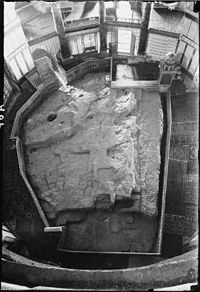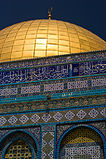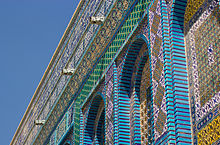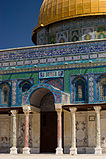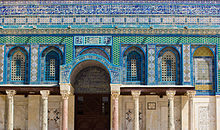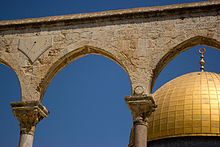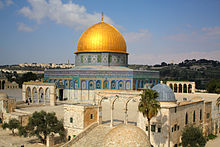- Dome of the Rock
-
The Dome of the Rock (Arabic: مسجد قبة الصخرة, translit.: Masjid Qubbat As-Sakhrah, Hebrew: כיפת הסלע, translit.: Kipat Hasela) is a shrine located on the Temple Mount in the Old City of Jerusalem. The structure has been refurbished many times since its initial completion in 691 CE at the order of Umayyad Caliph Abd al-Malik. The site's significance stems from religious traditions regarding the rock, known as the Foundation Stone, at its heart.
Contents
Location, construction and dimensions
The Dome of the Rock is located at the visual center of a platform known as the Temple Mount. It was constructed on the site of the Second Jewish Temple, which was destroyed during the Roman Siege of Jerusalem in 70 CE. In 637 CE, Jerusalem surrendered to the Rashidun Caliphate army during the Muslim conquest of Syria.
 Panorama of the Temple Mount, including Al-Aqsa Mosque and Dome of the Rock, from the Mount of Olives
Panorama of the Temple Mount, including Al-Aqsa Mosque and Dome of the Rock, from the Mount of Olives
The location of the Dome of the Rock was established as the site of the Islamic miracle of the Isra and Miraj by Caliph Omar ibn al Khattab, who was advised by his associate, Ka'ab al-Ahbar, a former Jewish rabbi who had converted to Islam, that Isra and Miraj took place at the site of the former Jewish Temples. The Dome of the Rock was erected between 689 and 691 CE. The names of the two engineers in charge of the project are given as Yazid Ibn Salam from Jerusalem and Raja Ibn Haywah from Baysan. Umayyad Caliph Abd al-Malik ibn Marwan who initiated construction of the Dome, hoped that it would “house the Muslims from cold and heat”[1] and intended the building to serve as a shrine for pilgrims and not as a mosque for public worship.[2]
 Print from 1887. Architect Frederick Catherwood was the first westerner known to have made detailed drawings of the Dome, which he accomplished during a six-week period in 1833.[3]
Print from 1887. Architect Frederick Catherwood was the first westerner known to have made detailed drawings of the Dome, which he accomplished during a six-week period in 1833.[3]
Shlomo Dov Goitein of the Hebrew University states that the Dome of the Rock was intended to compete with the many fine buildings of worship of other religions. The very form of a rotunda, given to the Qubbat as-Sakhra, although it was foreign to Islam,[citation needed] attempted to rival the many Christian domes of its time.[4] A.C. Cresswell in his book Origin of the plan of the Dome of the Rock notes that those who built the shrine used the measurements of the Church of the Holy Sepulchre. The diameter of the dome of the shrine is 20.20m and its height 20.48m, while the diameter of the dome of the Church of the Holy Sepulchre is 20.90m and its height 21.05m.
The structure is basically octagonal. It comprises a wooden dome, approximately 20 m in diameter, which is mounted on an elevated drum consisting of a circle of 16 piers and columns.[2] Surrounding this circle is an octagonal arcade of 24 piers and columns. During his travels in Jerusalem, American writer Mark Twain wrote that:
Every where about the Mosque of Omar are portions of pillars, curiously wrought altars, and fragments of elegantly carved marble – precious remains of Solomon's Temple. These have been dug from all depths in the soil and rubbish of Mount Moriah, and the Muslims have always shown a disposition to preserve them with the utmost care.[5]
The outer side walls are made of porcelain[6] and mirror the octagonal design. They each measure approximately 60 feet (18 m) wide and 36 feet (11 m) high. Both the dome and the exterior walls contain many windows.[2]
The Dome
Exterior
The Dome is in the shape of a Byzantine martyrium, a structure intended for the housing and veneration of saintly relics, and is an excellent example of middle Byzantine art. During the reign of Suleiman the Magnificent the exterior of the Dome of the Rock was covered with Iznik tiles. The work took seven years. Haj Amin Al-Husseini, appointed Grand Mufti by the British, along with Yacoub Al Ghussein implemented restoration of Dome of the Rock and Al Aqsa Mosque in Jerusalem.
In 1955, an extensive program of renovation was begun by the government of Jordan, with funds supplied by the Arab governments and Turkey. The work included replacement of large numbers of tiles dating back to the reign of Suleiman the Magnificent, which had become dislodged by heavy rain. In 1965, as part of this restoration, the dome was covered with a durable aluminum and bronze alloy made in Italy, that replaced the lead exterior.[7] The restoration was completed in August 1964. In 1993, the golden dome covering was refurbished following a donation of $8.2 million by King Hussein of Jordan who sold one of his houses in London to fund the 80 kilograms of gold required.
Interior
The interior of the dome is lavishly decorated with mosaic, faience and marble, much of which was added several centuries after its completion. It also contains Qur'anic inscriptions. Sura Ya-Seen is inscribed across the top of the tile work and was commissioned in the 16th century by Suleiman the Magnificent. Al-Isra is inscribed above this.
According to Goitein, the inscriptions decorating the interior clearly display a spirit of polemic against Christianity, whilst stressing at the same time the Qur'anic doctrine that Jesus was a true prophet. The formula la sharika lahu 'God has no companion' is repeated five times, the verses from Sura Maryam 19:35–37, which strongly reaffirm Jesus' prophethood to God, are quoted together with the prayer: Allahumma salli ala rasulika wa'abdika 'Isa bin Maryam – "In the name of the One God (Allah) Pray for your Prophet and Servant Jesus son of Mary". He believes that this shows that rivalry with Christendom, together with the spirit of Muslim mission to the Christians, was at work at the time of construction.[4]
History
Crusaders
During the Crusades the Dome of the Rock was given to the Augustinians, who turned it into a church while the Al-Aqsa Mosque became a royal stable. The Knights Templar, who believed the Dome of the Rock was the site of the Temple of Solomon, later set up their headquarters in the Al-Aqsa Mosque adjacent to the Dome for much of the 12th century. The "Templum Domini", as they called it, was featured on the official seals of the Order's Grand Masters (such as Everard des Barres and Renaud de Vichiers), and it became the architectural model for Templar churches across Europe
Ayyubids and Mamluks
Jerusalem was recaptured by Saladin on 2 October 1187, and the Haram was reconsecrated as a Muslim sanctuary. The cross on top of the Dome of the Rock was replaced by a golden crescent, and a wooden screen was placed around the rock below. Saladin's nephew al-Malik al-Mu'azzam Isa carried out other restorations within the Haram and added the porch to the Aqsa mosque.
The Haram was the focus of extensive royal patronage by the sultans during the Mamluk period, which lasted from 1250 until 1510.
Ottoman Empire 1517–1917
Large-scale renovation was undertaken during the reign of Mahmud II in 1817. Adjacent to the Dome of the Rock, the Ottomans built the free-standing Dome of the Prophet in 1620.
From British Mandate to present
The Dome of the Rock was badly shaken during an earthquake in Palestine on 11 July 1927, rendering useless many of the repairs that had taken place over previous years.
Israel took control of the Dome of the Rock during its victory in the Six-Day War in 1967. Shlomo Goren also entered the Dome of the Rock with a Torah book and a shofar.[8]
A few hours after the Israeli flag was hoisted over the Dome of the Rock in 1967 during the Six-Day War, Israelis lowered it on the orders of Moshe Dayan and invested the Muslim waqf (religious trust) with the authority to manage the Temple Mount / Haram al-Sharif, in order to "keep the peace".[9]
Groups such as the Temple Mount and Eretz Yisrael Faithful Movement wish to relocate the Dome to Mecca and replace it with a Third Temple. Since Muslim religious foundations own the Dome and consider it particularly sacred such actions would inevitably lead to violence. Many Israelis are ambivalent about the movement's wishes. Some religious Jews, following a rabbinic dictum, feel that the Temple should only be rebuilt in the messianic era, and that it would be presumptuous of people to force God's hand. However, some Evangelical Christians consider this a prerequisite to Armageddon and the Second Coming. This view is steeped in the belief that there will be a prophetic rebuilding of the Temple in place of the Dome of the Rock.
The Dome of the Rock is depicted on the reverse of the Iranian 1000 rials banknote.[10]
Accessibility
The Dome is maintained by the Ministry of Awqaf in Amman, Jordan.[11]
Until the mid-nineteenth century, non-Muslims were not permitted in the area. Since 1967, non-Muslims have been permitted limited access, however non-Muslims are not permitted to pray on the Temple Mount, or carry any form of religious artifact or anything with Hebrew letters. The Israeli police help enforce this.[12]
In 2006, the Temple Mount was reopened to non-Muslim visitors between the hours of 7:30–11:30 am and 1:30–2:30 pm during summer and 7:30–10:30 am and 1:30–2:30 pm during winter. Non-Muslims are prohibited from entering after 2:30 pm and may not enter on Fridays, Saturdays, or Muslim holidays. Entry is through a wooden walkway next to the entrance to the Western Wall. Non-Muslims are prohibited from entering the mosques and accessing the Temple Mount through the Cotton Market. Visitors are subject to strict security screening, and items such as Jewish prayer books are prohibited.[citation needed] Visits to the Dome of the Rock, however, are currently prohibited to non-Muslims who will be stopped by the guards as they approach the building.[citation needed]
Many Orthodox rabbis regard entry to the compound to be a violation of Jewish law. This is based on the belief that since the time the Temple was destroyed during the siege of Jerusalem in 70 CE, the precise location of the Holy of Holies, the sanctuary entered only by the High Priest, is not known. Hence a restriction applies to the entire compound. However, other rabbis believe that modern archeological and other evidence has enabled them to identify areas that can be safely entered without violating Jewish law. However even those opinions forbid Jews from entering the Dome of the Rock.[13]
Religious significance
 The Temple in Jerusalem depicted as the Dome of the Rock on the printer's mark of Marco Antonio Giustiniani, Venice 1545–52
The Temple in Jerusalem depicted as the Dome of the Rock on the printer's mark of Marco Antonio Giustiniani, Venice 1545–52
According to Islamic tradition, the rock is the spot[14] from which Muhammad ascended to Heaven accompanied by the angel Gabriel. Further, Muhammad was taken here by Gabriel to pray with Abraham, Moses, and Jesus.[15] After Muhammad's return, he called all who would believe him to join with him and be Muslim.[14]
The Foundation Stone and its surroundings is the holiest site in Judaism. Just as Muslims pray towards the Kaaba at Mecca, the holiest site in Islam, Jews pray towards the raised platform on which the Dome of the Rock stands. Jews have traditionally regarded the location of the stone as the holiest spot on Earth, the site of the Holy of Holies during the Temple Period. The Jewish tradition does not have information regarding the exact location of the Holy of Holies, but the majority of scholars and rabbis believe it is somewhere in the area of the raised platform.
The most propitious site for Jewish prayer is the spot that is nearest the Foundation Stone. Because Muslim authorities refused to permit Jewish prayer on the Temple Mount, the custom developed of praying near the Western Wall, since it was the site nearest to the Foundation Stone, or on the Mount of Olives facing the site of the Temple. Between 1948 and 1967, when Jordanian authorities refused permission to Jews to enter the Old City of Jerusalem, Jews made pilgrimages to rooftops on Mount Zion and prayed towards the site of the ancient Holy of Holies.[16]
According to Jewish tradition, the stone is the site where Abraham prepared to sacrifice his son Isaac.
In Christianity it is believed that during the time of the Byzantine Empire, near the spot where the Dome was later constructed was where Constantine's mother built a small church, calling it the Church of St. Cyrus and St. John, later on enlarged and called the Church of the Holy Wisdom.[17] On the walls of the Dome of the Rock is an inscription in a mosaic frieze that includes the following words from Quran (19:33–35), which are considered blasphemy to Christianity:
33. "So peace is upon me the day I was born, and the day I die, and the day I shall be raised alive!" 34. Such is Jesus, son of Mary. It is a statement of truth, about which they doubt. 35. It is not befitting to (the majesty of) Allah that He should beget a son. Glory be to Him! when He determines a matter, He only says to it, "Be", and it is.
The date recorded as 72 after the Hijra (or 691–692 CE), which historians view as the year of the Dome's construction.[18]
Architectural homages
A number of buildings have been designed as copies of the Dome of the Rock. These include the octagonal Church of St. Giacomo in Italy, and the octagonal Moorish Revival style Rumbach Street synagogue in Budapest. This was done because the Dome of the Rock was long believed by Christians to echo the architecture of the Temple in Jerusalem, as can be seen in Raphael's The Marriage of the Virgin and in Perugino's Marriage of the Virgin.[19]
Gallery
See also
- Al-Aqsa Mosque
- Foundation Stone
- Islamic architecture
- List of the oldest mosques in the world
- Temple Mount
- Well of Souls
- Dome of the Chain
- New Jerusalem
Notes
- ^ Abu-Bakr al-Wasiti, Fada'il Bayt al-Maqdis, pp. 80–81, vol 136
- ^ a b c Encyclopædia Britannica: Dome of the Rock
- ^ "Drawings of Islamic Buildings: Dome of the Rock, Jerusalem.". Victoria and Albert Museum. http://www.vam.ac.uk/collections/architecture/architecture_features/alternating_currents/collections/domeoftherock/index.html. "Until 1833 the Dome of the Rock had not been measured or drawn; according to Victor von Hagen, ‘no architect had ever sketched its architecture, no antiquarian had traced its interior design…’ On 13 November in that year, however, Frederick Catherwood dressed up as an Egyptian officer and accompanied by an Egyptian servant ‘of great courage and assurance’, entered the buildings of the mosque with his drawing materials … ‘During six weeks, I continued to investigate every part of the mosque and its precincts.’ Thus, Catherwood made the first complete survey of the Dome of the Rock, and paved the way for many other artists in subsequent years, such as William Harvey, Ernest Richmond and Carl Friedrich Heinrich Werner."
- ^ a b Goitein, Shlomo Dov; The Historication background of the erection of the Dome of the Rock, Journal of American Oriental Society, Vol. 70, No. 2, 1950
- ^ Mark Twain, The Innocents Abroad, Chapter LIV
- ^ Dome of the Rock, The. Glass Steel and Stone.
- ^ "Dome of the Rock". BiblePlaces.com. http://www.bibleplaces.com/domeofrock.htm. Retrieved 2 January 2011.
- ^ Photo of Shlomo Goren inside the Dome
- ^ Letter from Jerusalem: A Fight Over Sacred Turf by Sandra Scham
- ^ Central Bank of Iran. Banknotes & Coins: 1000 Rials. – Retrieved on 24 March 2009.
- ^ Hashemite Restorations of the Islamic Holy Places in Jerusalem – kinghussein.gov.jo – Retrieved 21 January 2008
- ^ Jerusalem's Holy Places and the Peace Process Marshall J. Breger and Thomas A. Idinopulos, Washington Institute for Near East Policy, 1998.
- ^ "Israel Streams: The State of the Jews, Right Now". Web.israelinsider.com. http://web.israelinsider.com/Articles/Politics/4839.html. Retrieved 2 January 2011.
- ^ a b Braswell, G. Islam – Its Prophets, People, Politics and Power. Nashville, TN: Broadman and Holman Publishers. 1996. p.14
- ^ Ali, A. The Holy Qur’an – Translation and Commentary. Bronx, NY: Islamic Propagation Centre International. 1946. p. 1625-1631
- ^ Jerusalem Divided: The Armistice Regime, 1947–1967, Raphael Israeli, Routledge, 2002, p. 6
- ^ Wilkinson, Jerusalem Pilgrims Before the Crusades, page 141
- ^ Rizwi Faizer (1998). "The Shape of the Holy: Early Islamic Jerusalem". Rizwi's Bibliography for Medieval Islam. Archived from the original on 10 February 2002. http://web.archive.org/web/20020210164811/http://us.geocities.com/rfaizer/reviews/book9.html.
- ^ Burckhardt, Jacob; Peter Murray, James C. Palmes (1986). The Architecture of the Italian Renaissance. University of Chicago Press. p. 81.
References
- Creswell, K. A. C., The Origin of the Plan of the Dome of the Rock (Jerusalem, British School of Archaeology in Jerusalem, 1924).
- Peterson, Andrew (1994). Dictionary of Islamic Architecture. London: Routledge. ISBN 0-415-06084-2
- Braswell, G. (1996). Islam – Its Prophets, People, Politics and Power. Nashville, TN: Broadman and Holman Publishers.
- Ali, A. (1946). The Holy Qur’an – Translation and Commentary. Bronx, NY: Islamic Propagation Centre International.
- Islam, M. Anwarul; Al-Hamad, Zaid, "The Dome of the Rock: Origin of its Octagonal Plan," Palestine Exploration Quarterly, 139,2 (2007), 109-128.
External links
- Dome of the Rock Bible places
- Dome of the Rock Sacred sites
- Re-envisioning the Dome of the Rock The Hope
- The Dome of the Rock in Jerusalem Masterpieces of Islamic Architecture
Coordinates: 31°46′41″N 35°14′07″E / 31.7780°N 35.2354°E
Islamic structures on the Temple Mount Mosque 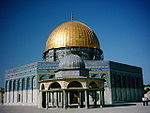
Domes Dome of the Ascension • Dome of the Chain • Dome of al-Khidr • Dome of al-Khalili • Dome of Moses • Dome of the Muezzin • Dome of al-Nahawiyyah Dome of the Prophet • Dome of the Rock • Dome of Solomon • Dome of the Spirits • Dome of Yusuf • Dome of Yusuf AghaFountains Fountain of Ibrahim al-Rumi • Fountain of Qasim Pasha • Fountain of Qayt Bay • Fountain of Sha'lan • Fountain of Sultan Solomon • Pool of RaranjOther structures Minarets See also Areas Gates Surrounding roads Synagogues/
Jewish holy sitesMosques/
Islamic holy sitesCategories:- Temple Mount
- Islamic architecture
- 690s architecture
- Umayyad architecture
- Jerusalem shrines
- Knights Templar
- Shrines
- Domes
- Octagonal buildings
- Arabic architecture
- Islam in Jerusalem
Wikimedia Foundation. 2010.









